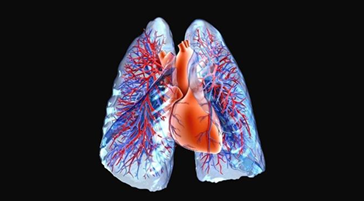Pulmonary hypertension (PH) is a disease in which the pressure in the pulmonary vessels (small circulation) increases. This should not be confused with high blood pressure in the large circulation (arterial hypertension).
Causes and Classification
Pulmonary hypertension is divided into five groups:
- Pulmonary arterial hypertension (PAH) – caused by the proliferation of smooth muscle cells in the small pulmonary arteries.
- PH associated with left heart disease.
- PH associated with lung diseases and chronic hypoxia (oxygen deficiency).
- Chronic thromboembolic pulmonary hypertension – resulting from chronic pulmonary embolism, where blood clots obstruct the large pulmonary vessels.
- PH with unclear and/or multifactorial mechanisms.
Chronic thromboembolic pulmonary hypertension (CTEPH)
Chronic Thromboembolic Pulmonary Hypertension (CTEPH) occurs when pulmonary emboli are not broken down by the body but instead form scar tissue. This scar tissue partially or completely blocks the pulmonary vessels, forcing the heart to pump much harder to push blood through the lung circulation. As a result, abnormally high blood pressure develops in the pulmonary circulation.

If left untreated, CTEPH progressively worsens: as pressure in the pulmonary vessels continues to rise, it can lead to reduced heart function and, ultimately, heart failure. Early diagnosis and treatment are therefore crucial.
Whether a patient with CTEPH is eligible for pulmonary endarterectomy (PEA) depends on factors such as the patient’s symptoms, the anatomical location, the extent of the disease, and the severity of pulmonary hypertension. A successful surgery can lower or normalize pulmonary pressure, leading to improved physical condition and increased life expectancy for the patient.
Symptoms of CTEPH
- Shortness of breath during physical exertion.
- Fatigue.
- Chest pain.
- Dizziness, sometimes leading to fainting.
- Heart palpitations.
- Cough.
- Hoarseness.
- Swollen feet.Enlarged liver and abdominal swelling.
- Swollen veins in the neck.
